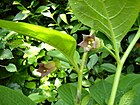Note: This is a project under development. The articles on this wiki are just being initiated and broadly incomplete. You can Help creating new pages.
Difference between revisions of "Atropa belladonna - Suchi, Deadly nightshade"
| Line 1: | Line 1: | ||
| − | |||
| − | |||
[[File:Atropa Bella-donna3.jpg|thumb|right|''Atropa belladonna'', ''Suchi'']] | [[File:Atropa Bella-donna3.jpg|thumb|right|''Atropa belladonna'', ''Suchi'']] | ||
| − | '''Atropa belladonna''' commonly known as '''belladonna''' or '''deadly nightshade''', is a perennial herbaceous plant (rhizomatous hemicryptophyte) in the Nightshade family (which includes tomatoes, potatoes, eggplant, etc.) Solanaceae, native to Europe, North Africa, and Western Asia | + | '''Atropa belladonna''' commonly known as '''belladonna''' or '''deadly nightshade''', is a perennial herbaceous plant (rhizomatous hemicryptophyte) in the Nightshade family (which includes tomatoes, potatoes, eggplant, etc.) Solanaceae, native to Europe, North Africa, and Western Asia. |
==Uses== | ==Uses== | ||
Revision as of 13:31, 4 July 2018
Atropa belladonna commonly known as belladonna or deadly nightshade, is a perennial herbaceous plant (rhizomatous hemicryptophyte) in the Nightshade family (which includes tomatoes, potatoes, eggplant, etc.) Solanaceae, native to Europe, North Africa, and Western Asia.
Contents
- 1 Uses
- 2 Parts Used
- 3 Chemical Composition
- 4 Common names
- 5 Properties
- 6 Habit
- 7 Identification
- 8 List of Ayurvedic medicine in which the herb is used
- 9 Where to get the saplings
- 10 Mode of Propagation
- 11 How to plant/cultivate
- 12 Commonly seen growing in areas
- 13 Photo Gallery
- 14 References
- 15 External Links
Uses
Arthritis, Irritable bowel syndrome, Asthma, Colds, Hay fever, Hemorrhoids, Motion sickness, Nerve problems, Spasms, Whooping cough.
Parts Used
Chemical Composition
hemical Composition.—The chief and most interesting constituent of belladonna is the alkaloid atropine (C17H23NO3) (see Atropina), first obtained in crystalline condition from the root by Mein and from the herb by Geiger and Hesse (Pharmacographia)[1]
Common names
| Language | Common name |
|---|---|
| Kannada | NA |
| Hindi | Angur Shefa, luckmuna |
| Malayalam | |
| Tamil | kBellatona, Pelletonacceti |
| Telugu | |
| Marathi | NA |
| Gujarathi | NA |
| Punjabi | NA |
| Kashmiri | NA |
| Sanskrit | Suchi |
| English | Belladonna, Devil's Cherries |
Properties
Reference: Dravya - Substance, Rasa - Taste, Guna - Qualities, Veerya - Potency, Vipaka - Post-digesion effect, Karma - Pharmacological activity, Prabhava - Therepeutics.
Dravya
Rasa
Guna
Veerya
Vipaka
Karma
Prabhava
Habit
Identification
Leaf
| Kind | Shape | Feature |
|---|---|---|
| simple | deciduous | Atropa belladonna is deciduous. The leaves are simple. They are ovate |
.[2]
Flower
| Type | Size | Color and composition | Stamen | More information |
|---|---|---|---|---|
| pale lavender | violet | 6-12 mm long | From June to July Atropa belladonna produces solitary pendant auburn flowers that are double and campanulate flowers |
Fruit
| Type | Size | Mass | Appearance | Seeds | More information |
|---|---|---|---|---|---|
| loose spiral | A curved or loose spiral seed pod is present | nil | seeds are yellow to brow.n in colour | 10 to 20 seed | {{{6}}} |
Other features
List of Ayurvedic medicine in which the herb is used
- Vishatinduka Taila as root juice extract
Where to get the saplings
Mode of Propagation
How to plant/cultivate
Atropa belladonna is rarely used in gardens, but, when grown, it is usually for its large upright habit and showy berries. Germination of the small seeds is often difficult, due to hard seed coats that cause seed dormancy. Germination takes several weeks under alternating temperature conditions, but can be sped up with the use of gibberellic acid. The seedlings need sterile soil to prevent damping off and resent root disturbance during transplanting.[3]
Commonly seen growing in areas
western Himalayas, open woodland, moisty soil area.
Photo Gallery
References
External Links
- Ayurvedic Herbs known to be helpful to treat Arthritis
- Ayurvedic Herbs known to be helpful to treat Irritable bowel syndrome
- Ayurvedic Herbs known to be helpful to treat Asthma
- Ayurvedic Herbs known to be helpful to treat Colds
- Ayurvedic Herbs known to be helpful to treat Hay fever
- Ayurvedic Herbs known to be helpful to treat Hemorrhoids
- Ayurvedic Herbs known to be helpful to treat Motion sickness
- Ayurvedic Herbs known to be helpful to treat Nerve problems
- Ayurvedic Herbs known to be helpful to treat Spasms
- Ayurvedic Herbs known to be helpful to treat Whooping cough
- Herbs with Leaves used in medicine
- Herbs with Root used in medicine
- Herbs with tops used in medicine
- Herbs with common name in Hindi
- Herbs with common name in Tamil
- Herbs with common name in Sanskrit
- Herbs with common name in English
- Habit - perennial branching herb
- Index of Plants which can be propagated by Seeds
- Index of Plants which can be propagated by Stem cutting
- Herbs that are commonly seen in the region of western Himalayas
- Herbs that are commonly seen in the region of open woodland
- Herbs that are commonly seen in the region of moisty soil area
- Herbs


